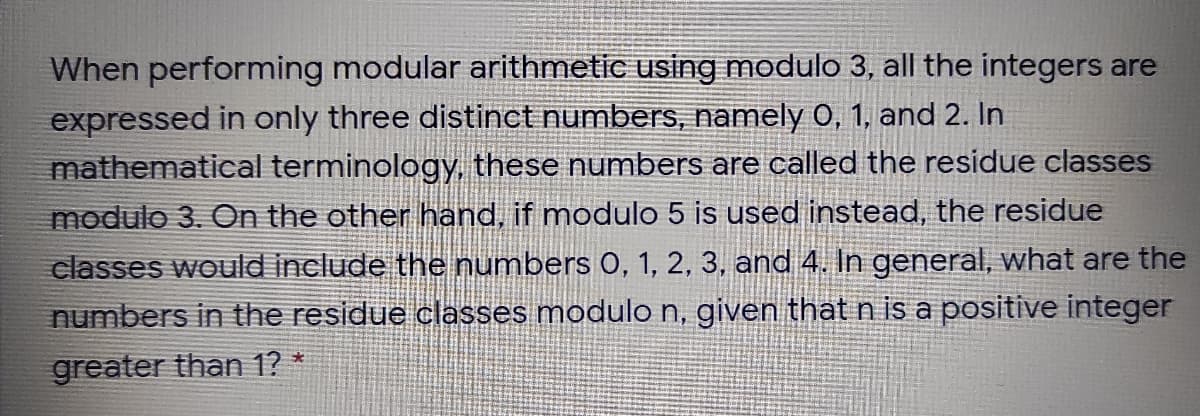When performing modular arithmetic using modulo 3, all the integers are expressed in only three distinct numbers, namely 0, 1, and 2. In mathematical terminology, these numbers are called the residue classes modulo 3. On the other hand, if modulo 5 is used instead, the residue classes would include the numbers 0, 1, 2, 3, and 4. In general, what are the numbers in the residue classes modulo n, given that n is a positive integer greater than 1? *
When performing modular arithmetic using modulo 3, all the integers are expressed in only three distinct numbers, namely 0, 1, and 2. In mathematical terminology, these numbers are called the residue classes modulo 3. On the other hand, if modulo 5 is used instead, the residue classes would include the numbers 0, 1, 2, 3, and 4. In general, what are the numbers in the residue classes modulo n, given that n is a positive integer greater than 1? *
Elements Of Modern Algebra
8th Edition
ISBN:9781285463230
Author:Gilbert, Linda, Jimmie
Publisher:Gilbert, Linda, Jimmie
Chapter2: The Integers
Section2.2: Mathematical Induction
Problem 46E: Use generalized induction and Exercise 43 to prove that n22n for all integers n5. (In connection...
Related questions
Question

Transcribed Image Text:When performing modular arithmetic using modulo 3, all the integers are
expressed in only three distinct numbers, namely 0, 1, and 2. In
mathematical terminology, these numbers are called the residue classes
modulo 3. On the other hand, if modulo 5 is used instead, the residue
classes would include the numbers 0, 1, 2, 3, and 4. In general, what are the
numbers in the residue classes modulo n, given that n is a positive integer
greater than 1? *
Expert Solution
This question has been solved!
Explore an expertly crafted, step-by-step solution for a thorough understanding of key concepts.
Step by step
Solved in 2 steps with 2 images

Recommended textbooks for you

Elements Of Modern Algebra
Algebra
ISBN:
9781285463230
Author:
Gilbert, Linda, Jimmie
Publisher:
Cengage Learning,

Elements Of Modern Algebra
Algebra
ISBN:
9781285463230
Author:
Gilbert, Linda, Jimmie
Publisher:
Cengage Learning,